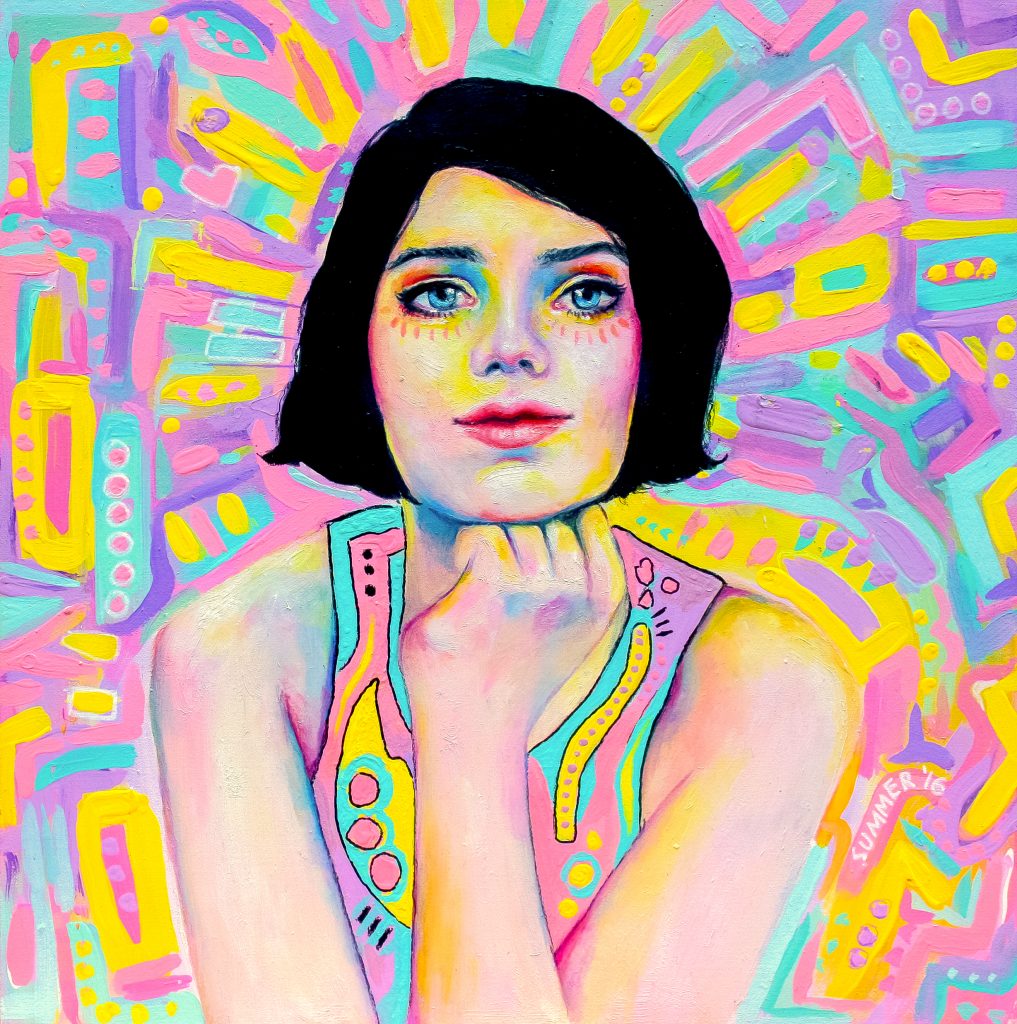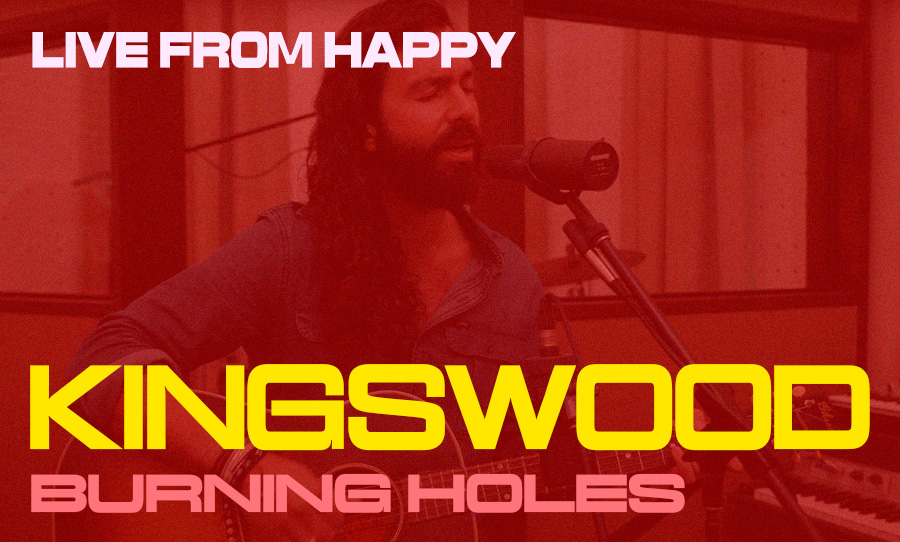Radiating the light of a thousand dopamine-laced, technicolour suns is Amy Summer’s array of pastel-rich collages and self-portraits. With a playful exuberance, Summer’s art hits you right in the inner child; stoking up old memories of shamelessly indulging in a packet of Zappos, and laughing at B1’s jokes like they were the funniest thing we’d ever hear (they weren’t).
We caught up with the self-professed ‘plant eater’ to discuss the cultural compartmentalisation of colours, the price of working for free, and the exploitative practices of so-called ‘fast fashion’ corporations.
With a big year of firsts, including curating her first solo show at Goodspace Gallery and exhibiting overseas at Joy Gallery in San Francisco, it would appear that Summer’s star has only just begun to rise.

Like a rose between two thorns, Amy Summer’s work stands out as a beacon of joy and hope within an industry that’s too frequently marred by tragedy.
HAPPY: So Amy, tell us a bit about yourself. Where did you grow up, and what kind of artist would you describe yourself as?
AMY: I grew up in a beachy, regional town on the mid-north coast. I live in Sydney now, and I like the city much better. I feel increasingly like a multi-disciplinary artist, cause I’m gonna pick up any tool or medium that makes my little heart sing. I actually have an art theory degree, and the unforeseen result of that is an extreme dislike of the pretentiousness of traditional galleries. If anything, the best thing about studying art history is a robust insight into everything I want to obliterate from the art institution.
HAPPY: Your work often collages the old with the new. What’s the attraction there?
AMY: I think I like the regality and opulence of historical art and imagery. When combined with the contemporary in a playful, or irreverent way, it seems both alluring and slightly jarring. I enjoy that.

HAPPY: You also use a lot of bright colours. Do you think that’s a reflection of your personality?
AMY: I’ve always just been drawn to colour, I find it exciting and it genuinely makes me happy. There’s a drawing I did when I was four that I (apparently) called Waterfall, and it’s just all these colours smooshed together into an arch shape. Maybe it’s colour that has shaped my personality and not the other way around…
HAPPY: What do you think when people pigeonhole the use of certain colours as ‘feminine’ or ‘kiddish’?
AMY: Most of it is just social conditioning. We’ll automatically see something that is black and white as more serious than something that is super colourful. Blue is for boys, pink is for girls, green is envy etc. Colour has so much obvious and hidden power because of this. I have no problem with my use of colour being seen as ‘kiddish’ because a kind of child-like exuberance is something that I really vibe on. When my work is described as ‘feminine’ or ‘girly’ because I happen to use pink, I find it trickier. Not because there is anything essentially wrong with these terms, but historically they have been used to compartmentalise female artists and devalue their efforts.

HAPPY: Do you think third wave feminism has played a role in the increased visibility of female artists in what has been a male-dominated industry?
AMY: Yes. And there’s still a long road ahead of us.
HAPPY: Is value in working for free as an emerging artist, or do you think people should abstain from working without commission?
AMY: I recently made a silly video in frustration about the whole ‘work for exposure’ explosion. It’s not just an emerging artist thing either. A few established creatives contacted me after seeing the video to say that it happens regularly to them too.
At times there are definitely benefits in working for free, but it depends on the context. Collaboration, charity work, helping mates or family out; that’s all great! But if you’re a large company who approaches an emerging artist offering them a “great opportunity” with “no budget”… Then no. Just no. This stuff happens too often and it’s really vexing when you’re on the receiving end.
It’s part of a wider problem where art is culturally undervalued. We saw this recently with the funding cuts for “lifestyle choices” i.e. arts-related tertiary education. One day I want all artists and creatives in the world to stop working and we can see how interesting life is then.

HAPPY: What are your thoughts on fast fashion corporations like ZARA ripping designs off young, up-and-coming creatives like yourself?
AMY: I don’t think this has happened to me, but it has to some people I know. It fucking sucks. It’s just plain rude. I actually made a pact with myself about six months ago to stop buying fast fashion or basically anything other than essential items. I struggle to deal with the insatiable greed of these corporations.
HAPPY: Have you ever experienced any sort of exploitation as an artist?
AMY: Nothing too extreme. There’s been a few times where I’ve regretted doing things for free or didn’t assert myself as well as I should have. Nowadays, if I get an absurd request I’ll just give a polite “no thanks” and that’s the end if it.
HAPPY: What’s an average working day like in the life of Amy Summer?
AMY: Oh dear… My friends know I live a very strange life compared to a 9-5 working human. It always starts with coffee, and from there it really depends. I might go a week on three hours sleep each night working on freelance projects or whatever obsession is occupying my mind, and the next week will be solely dedicated to being a snorlax, maybe an occasional modeling job, or lazing around sketching in parks. At times it sucks and I’m really broke, but other times it’s amazing and really satisfying. I wouldn’t have it any other way.

HAPPY: Who are some of your favourite artists at the moment?
AMY: I’ve rekindled my love of the Guerrilla Girls and Judy Chicago, and Rebecca Baumann and Richard Bell are sick Australian artists… plus I just discovered Hannah Faith Yata – her paintings are incredible!
HAPPY: What are your plans for 2017? Any exhibitions or projects on the horizon?
AMY: My concept of time is pretty whacked out. At this point, I’m planning to study graphic design, and I have an idea for another solo show brewing away. Lately I’ve been drawn to making videos, so I could see myself doing more of those. We’ll see.



